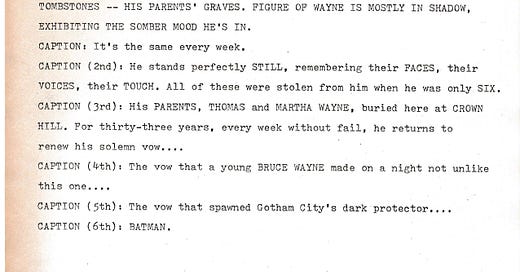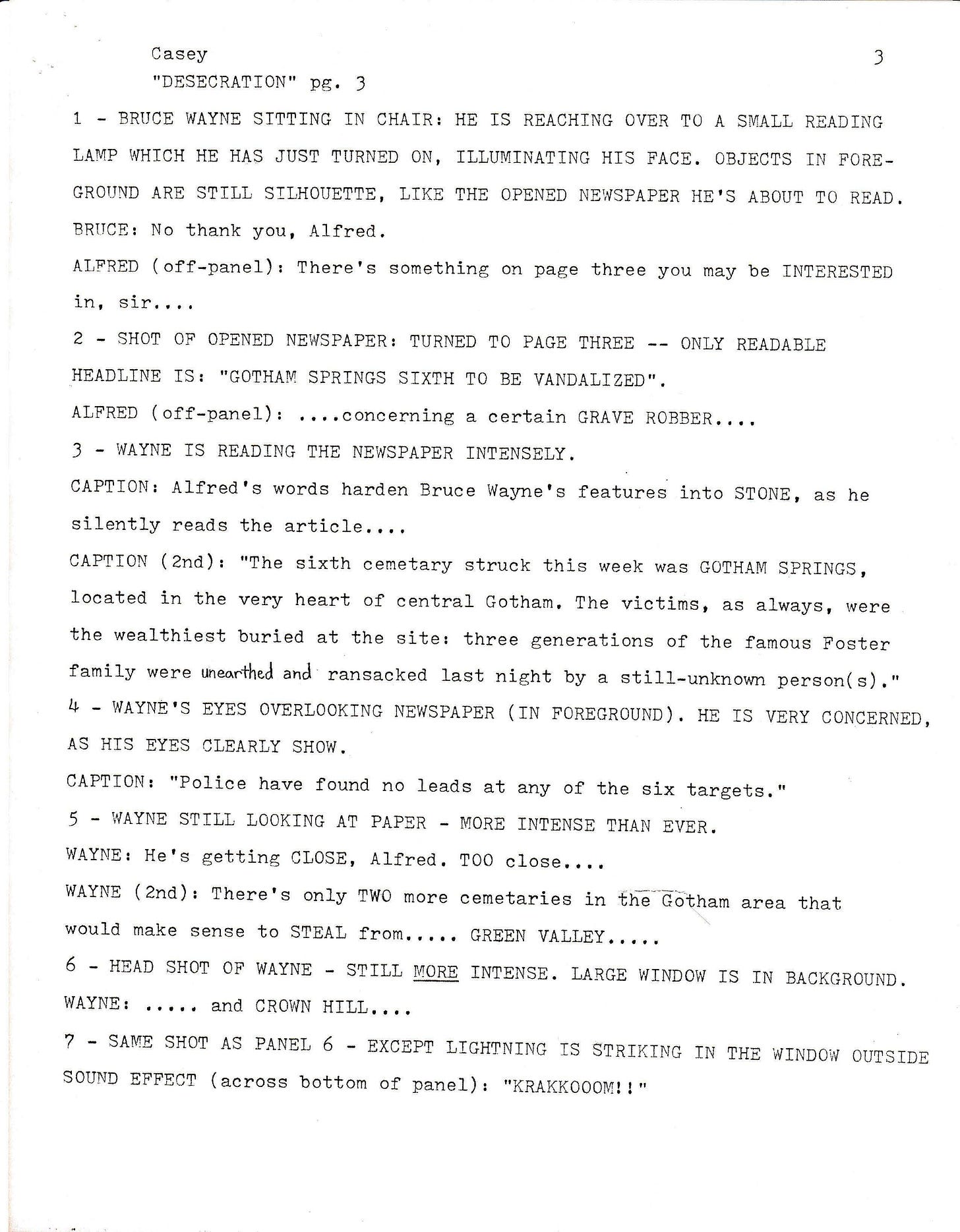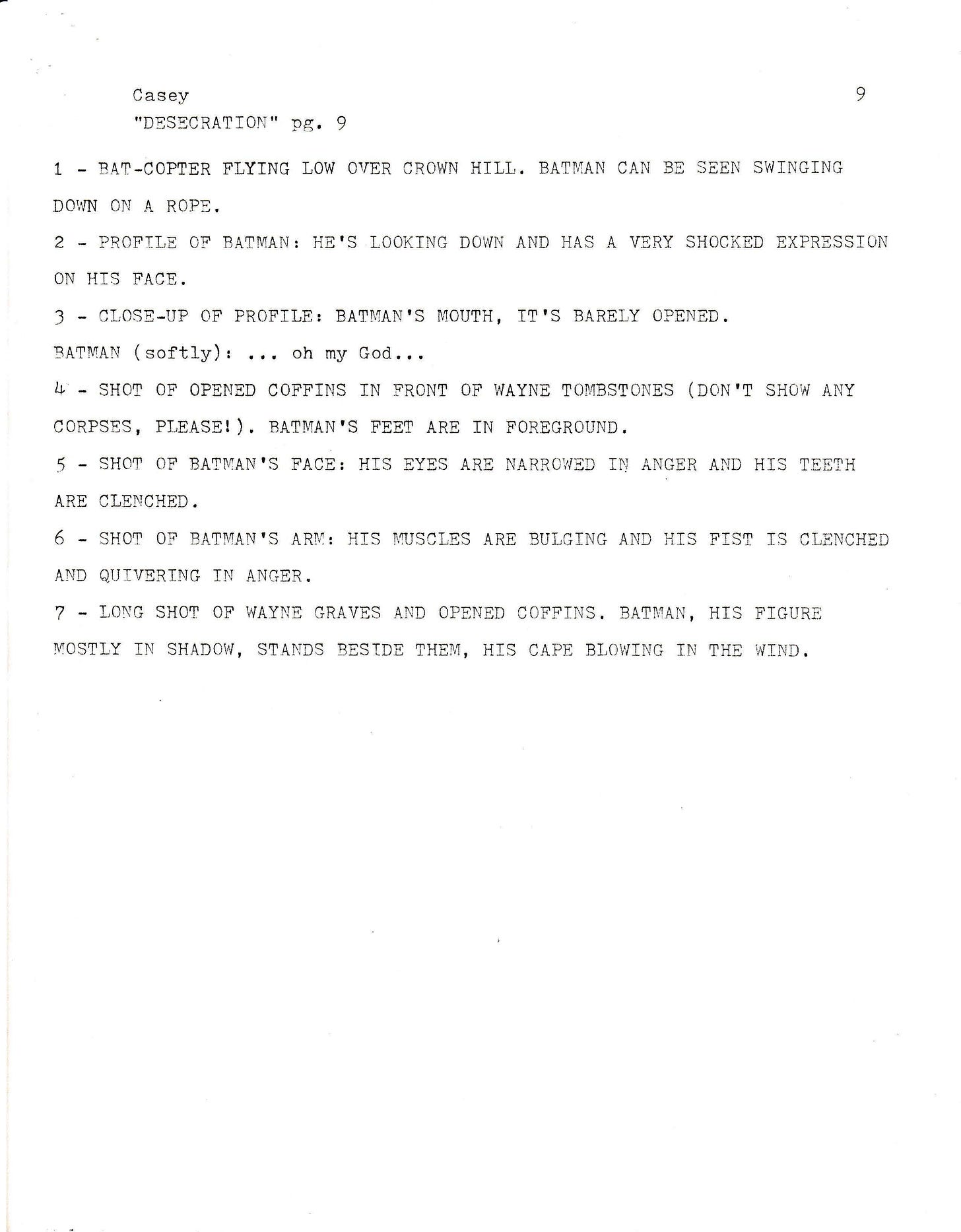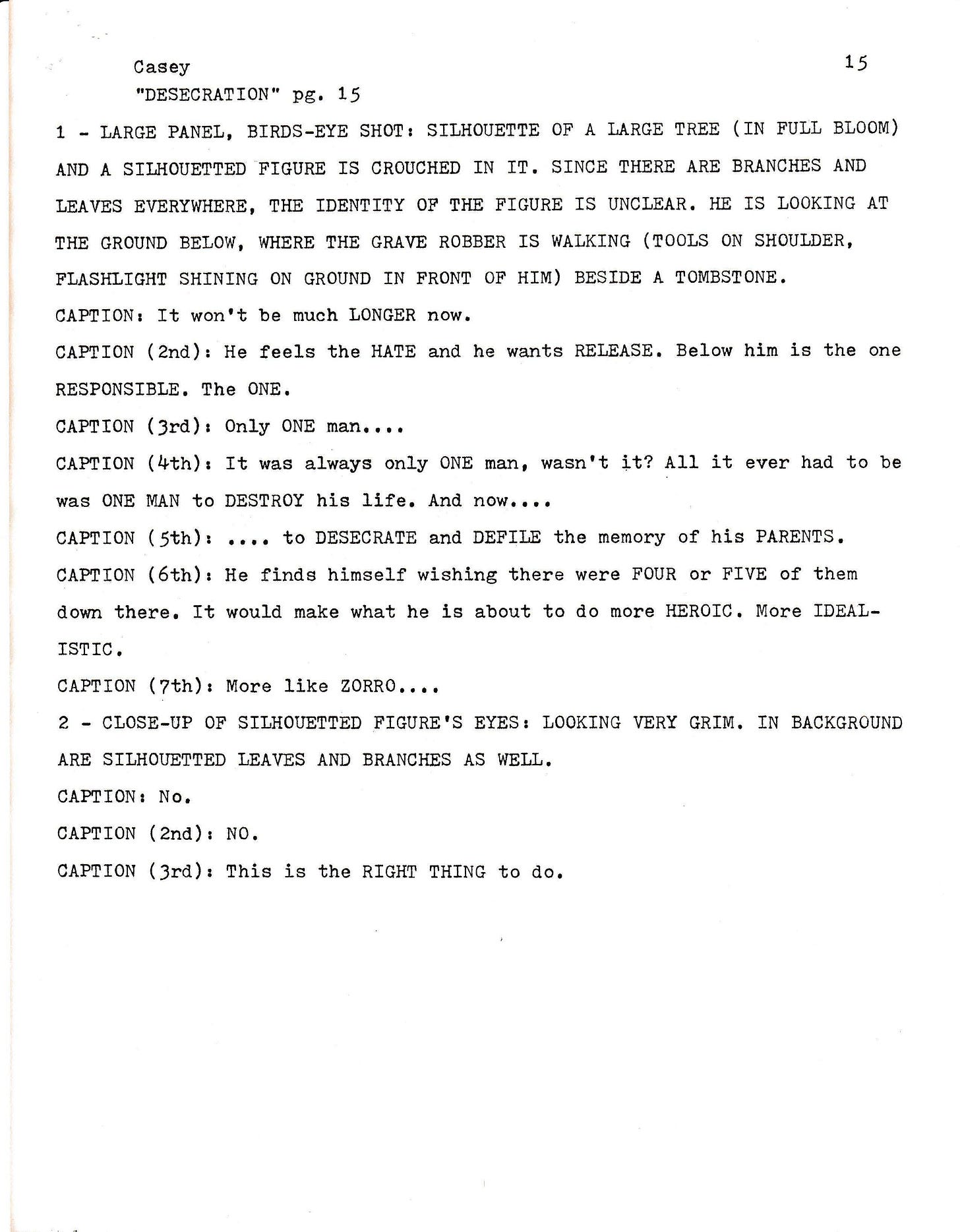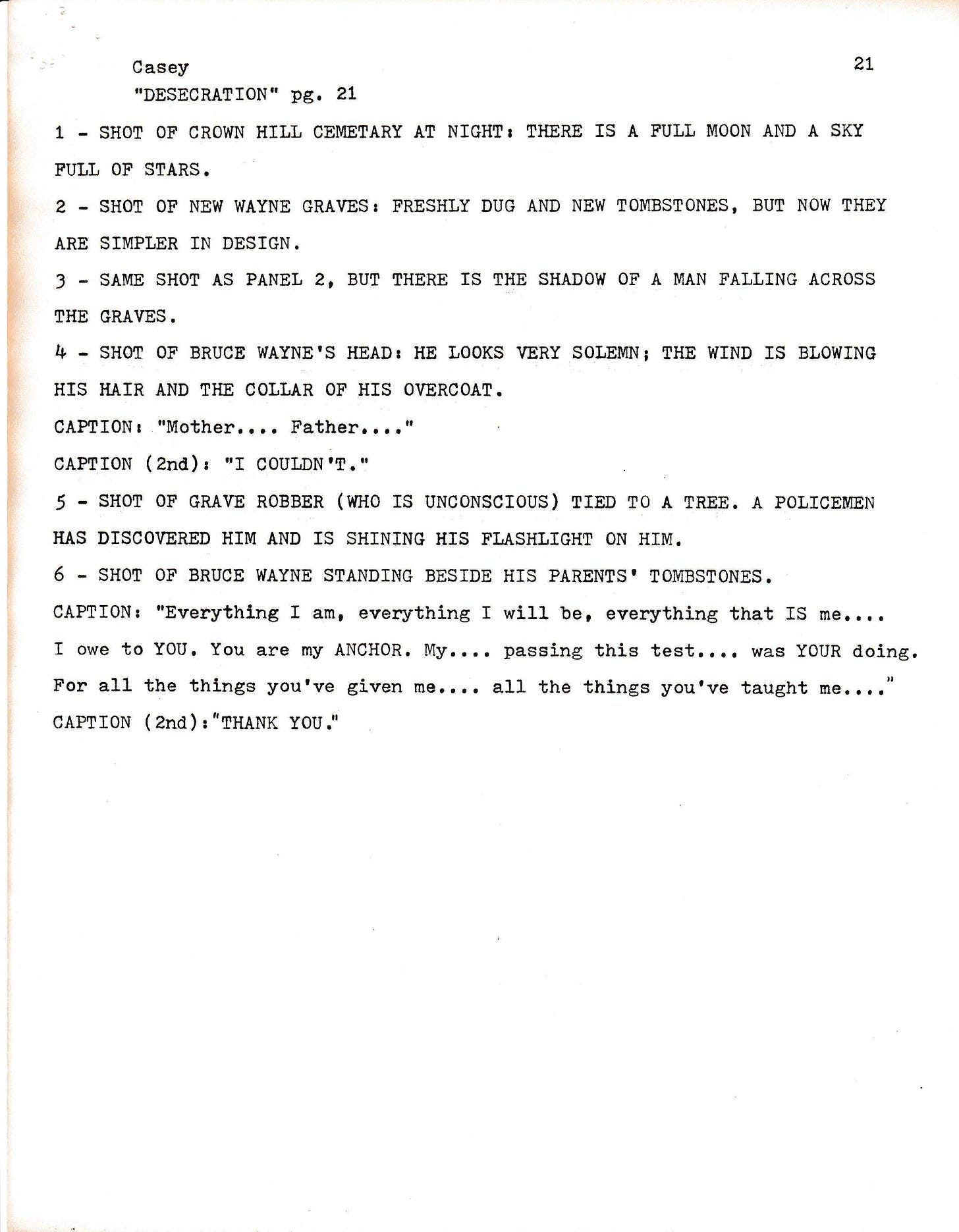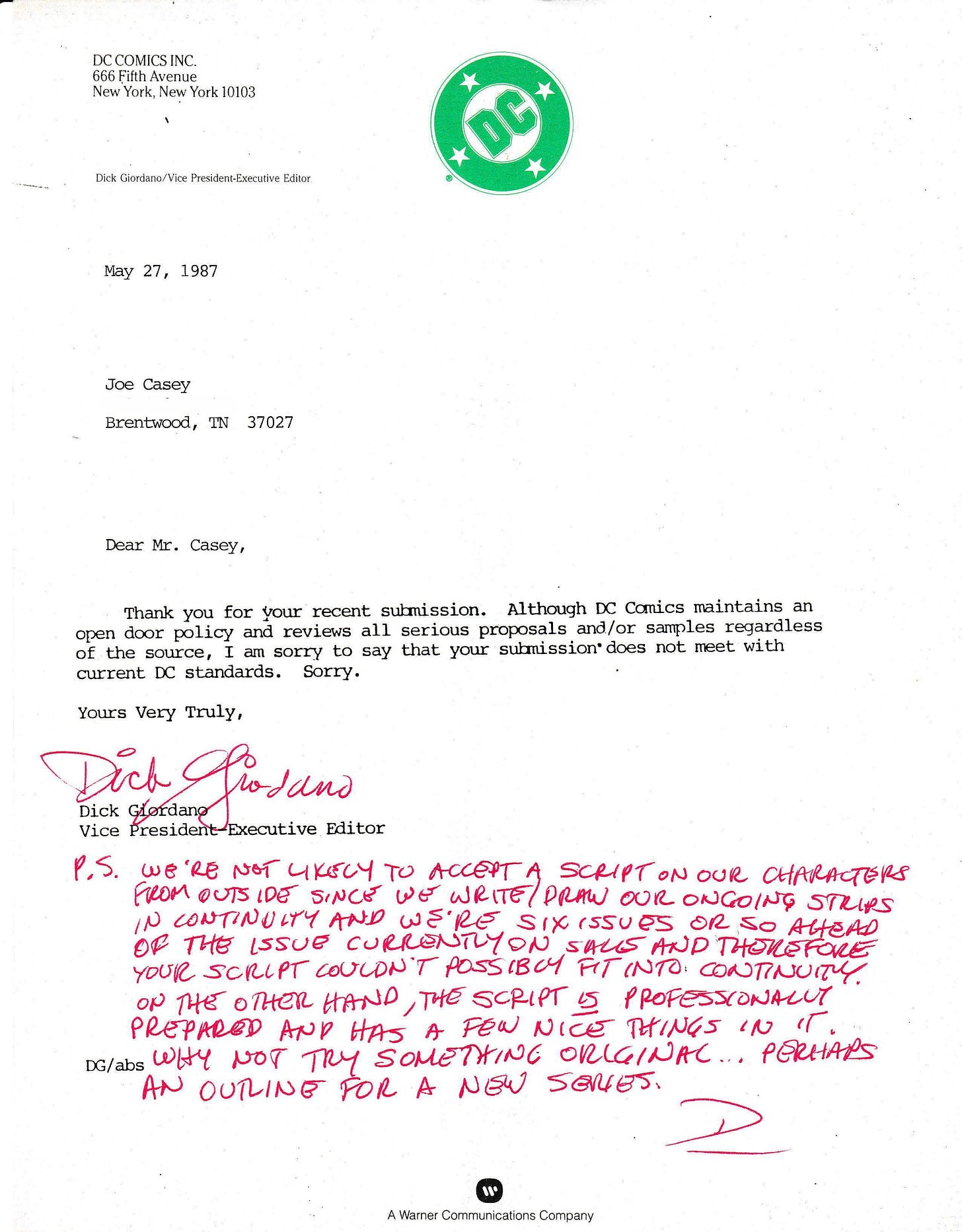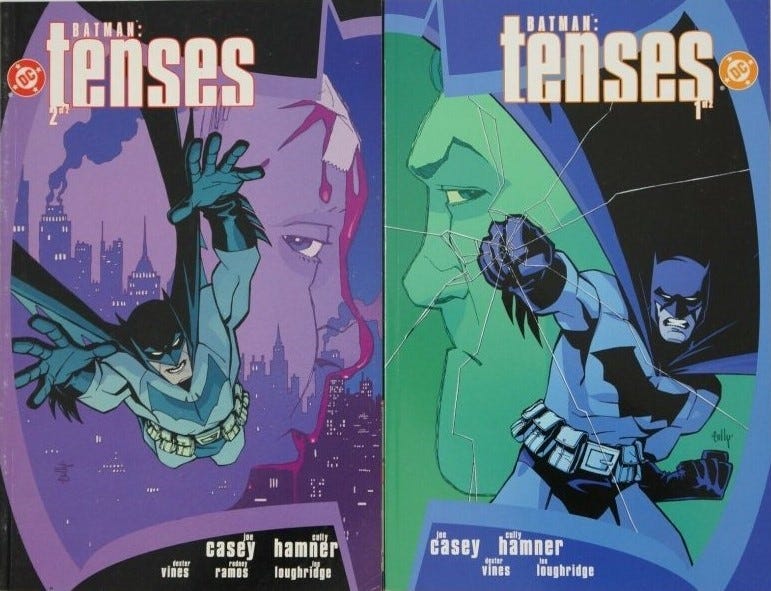Let me say this right up front: everything I’m about to lay out for you is the absolute truth… to the best of my ability to accurately remember events that occurred almost forty years ago. Take that disclaimer for what it’s worth. Luckily, I have the receipts to back me up.
In early 1987, I figured I was perfectly good and ready to throw my proverbial hat into the ring, to take the shot I knew was probably inevitable since the day -- almost a year previous -- when I first read Book Two of The Dark Knight Returns and fell in love with comicbooks all over again (discussed in some detail in a previous newsletter). I had that fire in my belly, and I was fairly confident that I could step up and make the transition into being a professional comicbook writer, specifically for DC Comics, the oldest and perhaps most venerable publisher in the industry.
I was sixteen years old.
I don’t recall if I was intimately aware of the “origin stories” of legendary comicbook writers, Jim Shooter and Gerry Conway, both who broke in as teenage writers and kicked off very well-respected and lengthy careers in the comicbook industry. I suspect I must’ve had some idea -- especially about Shooter -- that gave me the notion that I could make this happen, too. Otherwise, I would’ve just been completely and delusional and ignorant, right…?
Plus, I had a Batman story in my head. Admittedly, my Bat-fandom was still in full bloom. Dark Knight Returns might’ve ended the previous fall, but early ’87 gave us Frank Miller’s second knockout punch with Batman: Year One (along with artist extraordinaire, David Mazzucchelli) running in four chapters in the monthly Batman series. I mean, imagine trying to write your own Batman script while that comicbook is being published…!
But, like I said, I had an actual story to tell, a story that held some resonance for me, even at that young age. It involved a series of Gotham City grave robberies targeting the wealthy (the conceit being that rich people are often buried wearing some of their expensive jewelry/accessories/etc). Naturally, the graves of Thomas and Martha Wayne would be a possible target, and Batman is determined to protect his parents (in death, as he couldn’t in life). Hence the story title, “Desecration”.
What follows are just a few script excerpts. I’m not going to put you, the reader, or myself through the prolonged torture of presenting the entire script. I think these few pages give you a pretty good idea of what I was trying to do. By no means am I claiming that this is some sort of “lost classic”. It’s not. But it’s interesting, given what happened to me about a decade later…
Even from Page One, you sure can tell I had embraced Batman: Year One in a big, bad way. On every level, that was the most “realistic” superhero comicbook I’d ever read up until that point. So I leaned into it here, starting with a splash page that was more emotional than it was an over-the-top action shot. Having said that, it’s still fairly caption-heavy, using omniscient narration to set the scene. Probably a little more Denny O’Neil than Frank Miller.
In fact, the formatting of this script was one I’d lifted lock, stock and barrel from an example I’d seen -- of a Denny O’Neil script from an issue of Batman Family -- that had been reprinted in one of the many fanzines I’d been devouring at that point. I’d venture to guess it was seeing that example that emboldened me to actually write this script in the first place, since I’d been given a vital key to coming up with something that at least looked like a professional comicbook script. I’m pretty sure I followed the format to the letter.
Reading it now, it’s also a little too “new reader” friendly, presenting the basic tenets of the Batman concept right off the bat (no pun intended) in a fairly on-the-nose manner. Oh well… I was erring on the side of caution, I suppose.
So… by Page Three, I’ve set up the basic conflict of the grave robberies. I’m actually pretty happy with how concise this is. One page, done. And I’m also a little gratified that I used the dry, no-nonsense (meaning, no style) writing generally found in a newspaper article as a way to sidestep the fact that I couldn’t write with much style anyway. It was a way to get exposition out there with no fuss, no muss. The final two panels of this page, the convenient lightning strike with the accompanying “KRAKKOOOM!!”, is right out of Dark Knight Returns. Hey, if you’re gonna steal, steal from the best…
Page Nine: Now, in the interim pages not shown here, Batman plans to stake out Crown Hill Cemetery in order to protect his parents’ graves from being robbed. However, once he’s there, on his stakeout, an emergency hostage situation in Gotham momentarily calls him away. By the time he returns, the grave robber has struck (to his horror). It’s kind of interesting how much silent storytelling is on display here, as well as somewhat gratifying that I could show that much restraint so early on in my development as a writer. I also get a kick out my request to the (nonexistent) artist in Panel 4: “(don’t show any corpses, please!)”
Page Fifteen: So the (copious) captions in Panel 1 attempt to make the connection that it’s always “one man” that can make such a profound impact on your life… whether it’s Joe Chill (who murdered Bruce Wayne’s parents) or this grave robber or Batman himself, it can all come down to one man. Not a bad insight, I guess.
One thing I should mention, as established back on Page Three, there were only two cemeteries left if the grave robber(s) were going to follow a (admittedly) predictable pattern. So, having hit the Wayne graves at Crown Hill, that left one, final cemetery to be targeted. This made it easy (convenient? contrived?) for Batman to be there for the final grave robbery attempt. My “twist” on this confrontation was that, unlike the stakeout at Crown Hill in full bat-suit regalia, this time it was simply Bruce Wayne -- the man as opposed to the caped crusader -- that would be there.
Then there was the classic moment where, after suitably intercepting and pummeling the grave robber, Bruce has a chance to satisfy his bloodlust, to take out on this poor grave robber all of the unquenchable rage over his parents’ murder. An eye for an eye, as it were.
Of course, in the end, Batman doesn’t kill…
… as Page Twenty-One confirms. I’d left it as a bit of a cliffhanger on a previous page, and here on this page, I confirm that no “revenge kill” actually took place, that the grave robber was simply left for the authorities to discover and arrest. And, to mirror the opening scene of the script, Bruce is back at his parents’ restored grave sites, paying his respects and reaffirming his vow to wage his unending war on crime.
So there you have it. Obviously not a great piece of writing, but at the time it felt right. It felt like a satisfying, done-in-one story. It was specific to Batman (as opposed to a story where you could plug almost any superhero into and the story would still work). And, perhaps most notably, there’s not a super-villain to be found. For whatever reason, I didn’t want to tell a “vs.” story… Batman vs. the Joker or Batman vs. the Penguin… I guess I thought I’d be better off telling a more personal story, highlighting the fact that maybe I understood the Batman/Bruce Wayne character on a fundamental level, which is what you want to get across in a sample spec designed to get you a job.
In any case, I sent this script off to DC Comics and went on with my life.
Not long after, in early June 1987, I received a response from DC Comics. A rejection letter. More specifically, a form letter that obviously went out to anyone submitting unsolicited work at that time. If memory serves, I wasn’t all that disappointed. I might’ve been overly ambitious, but I wasn’t completely naïve. I’d always known it was a long shot.
But, as I read through the letter, I quickly saw there was a handwritten note in red ink at the bottom of the paper. The red ink matched the red ink of the signature that closed out the form letter: Dick Giordano.
Now, Dick Giordano was already a legend in 1987. Sure, he was a top flight artist/inker. But he’d also made his bones as an editor at Charlton Comics in the mid-1960’s. After an initial, brief stint in the DC editorial office, he formed Continuity Associates studios with legendary artist, Neal Adams. In the 1980’s, he was back at DC, serving as Vice President/Executive Editor. Always well-known for being extremely talent friendly, to my mind he was one of the main, guiding lights spearheading DC Comics’ revitalization as a publisher. He was Frank Miller’s main editorial support on the Dark Knight Returns project. To me, that said it all.
So, apparently, Dick Giordano had taken time out from whatever busy day he was having to write a handwritten note -- to me -- at the bottom of my rejection letter. It read:
“P.S. We’re not likely to accept a script on our characters from outside since we write/draw our ongoing strips in continuity and we’re six issues or so ahead of the issue currently on sale and therefore your script couldn’t possibly fit into continuity. On the other hand, the script is professionally prepared and has a few nice things in it. Why not try something original… perhaps an outline for a new series. D.”
And here’s the actual letter…
Maybe this was something he did all the time. I have no idea. Regardless, I was floored by this level of personal response. Keep in mind, I didn’t submit this script with a note that revealed, “By the way, I’m only sixteen.” No way. I’d simply submitted it and, by God, not only had they taken it seriously, but Dick Giordano himself was encouraging me to try again…!
So… did I take his suggestion and send anything further to DC Comics? No, I did not. Instead, I turned my immediate attention to my own comicbooks, my own ideas, furthering my own comicbook education, and to be perfectly honest, getting on with teenage life, in general. I mean, that can be complicated enough. Despite the massive affirmation Dick’s note provided me, I suppose -- deep down -- I knew I wasn’t ready. It might’ve seemed a little “anti-ambitious” for my Type A personality, but I needed to cook a little while longer…
My first published work for DC Comics as a professional writer occurred some fourteen years later. And three years or so after that, my first Batman project, titled BATMAN: TENSES was released.
It won’t be my last. Funny how life sometimes works out, isn’t it…?
Joe Casey
USA

